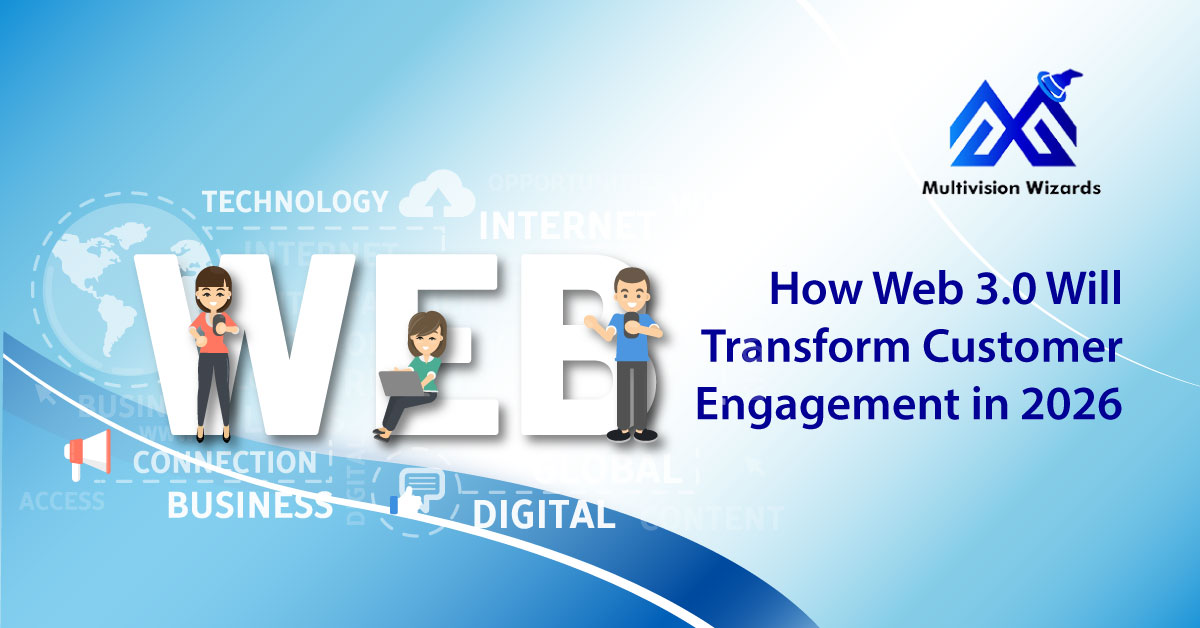How Web 3.0 Will Transform Customer Engagement in 2026

The internet has always been about connection. But as we move into a new era, that connection is about to become more personal, more secure, and more meaningful. That’s what Web 3.0 promises — a world where people aren’t just users but active participants.
At Multivision Wizards, we believe that the way brands engage with their audience is on the edge of its biggest transformation yet. Not through more noise or more ads, but through deeper trust, ownership, and transparency. Let’s explore what this shift means — and why 2026 will mark a turning point for digital engagement.
Understanding Web 3.0 — The Internet Evolves
Before we look ahead, let’s quickly understand where we’ve come from.
Web 1.0
Web 1.0 was about information. You could read, browse, and absorb, but not interact much.
Web 2.0
Web 2.0 brought interactivity — social media, apps, e-commerce, and user-generated content.
Web 3.0
Web 3.0 is where the user becomes the owner. It’s built around decentralization, privacy, and personalized digital experiences that put power back into people’s hands. In simple words, it’s not about companies controlling data — it’s about customers owning it. And that small shift changes everything about how businesses will connect with people.
The Changing Rules of Customer Engagement
For years, brands have relied on platforms and algorithms to reach audiences. The issue? Those platforms owned the data. Businesses had access, but not control.
Web 3.0 flips that model. In this new ecosystem, customers choose what they share, where they interact, and how they engage. That means brands will need to earn attention — not just buy it.
At Multivision Wizards, we see this as an incredible opportunity. When people have more say in the conversation, engagement stops being a one-way street. It becomes a collaboration.
Here’s what that looks like in action:
- More transparency in how brands use data.
- Personalized experiences designed around real consent.
- Community-led growth, not platform-led campaigns.
It’s engagement, but on equal terms.
1. Ownership Will Redefine Loyalty
In the Web 2.0 world, loyalty programs were based on rewards. In Web 3.0, they’ll be based on ownership. Imagine a customer who doesn’t just earn points — but actually owns a piece of your brand’s digital journey.
Through blockchain-backed tokens, brands can give customers more than discounts — they can give them influence, access, and identity. Loyalty, in this world, won’t just be about benefits. It’ll be about belonging. That’s how relationships move from transactional to emotional — something we, at Multivision Wizards, consider the true measure of long-term engagement.
2. Trust Becomes the New Currency
We live in an age of skepticism — people read reviews before believing ads, and transparency matters more than ever. Web 3.0 gives brands a chance to rebuild that trust from the ground up.
Here’s how:
- Transactions and data are more secure.
- Users control their personal information.
- Authenticity can be verified without middlemen.
This means brands that prioritize clarity and accountability will thrive. In 2026, the most successful companies won’t be the loudest ones — they’ll be the ones people trust without hesitation.
3. Communities Will Replace Traditional Audiences
The old model of marketing treated audiences as groups to target. Web 3.0 sees them as communities to build.
Through decentralized networks, people with shared interests can gather, collaborate, and co-create brand stories. This community-driven engagement makes customers feel seen, heard, and valued — not just sold to.
For businesses, that means more organic advocacy, stronger loyalty, and conversations that grow naturally. At Multivision Wizards, we’ve already started helping brands transition into this model — where every follower becomes a contributor.
4. Personalization Without Intrusion
The beauty of Web 3.0 is that personalization no longer comes at the cost of privacy. Customers can share specific data to improve their experience while keeping control of what remains private.
So instead of algorithms guessing what people want, they’ll simply tell you — and trust that you’ll use that information responsibly. This shift creates a new kind of digital intimacy — one that feels natural, not invasive. For marketers, that’s gold. For users, it’s respect.
5. The Experience Economy Will Expand
By 2026, customers won’t just buy products — they’ll invest in experiences. Web 3.0 will make that easier through immersive technologies and community-driven ecosystems.
Picture this:
- A fashion brand hosting digital try-ons in a virtual boutique.
- A fitness company rewarding consistent progress with exclusive event access.
- A local café offering digital collectibles tied to real-world benefits.
It’s engagement that’s both digital and deeply personal. And it’s coming faster than most businesses expect.
6. Data Will Finally Work For the Customer
For years, data has been extracted, tracked, and sold — often without clarity or consent. Web 3.0 changes that narrative entirely. Customers will be able to decide who can access their information and for what purpose.
That means data becomes a form of collaboration — not exploitation. Brands that handle this responsibly will earn long-term trust and loyalty. Those that don’t will simply fade out of relevance. At Multivision Wizards, we’re helping businesses prepare for this shift — with strategies that make transparency a part of their identity, not an afterthought.
The Shift from Attention to Intention
One of the biggest mindset changes in 2026 will be this: Brands will stop chasing attention and start building intention. Attention gets you a click. Intention earns you a relationship.
Every like, share, or purchase in the Web 3.0 world will have more meaning — because users will engage by choice, not manipulation. That’s a win for both sides.
Preparing for the Web 3.0 Transition
For most businesses, the hardest part isn’t adapting to new tools — it’s changing how they think. Web 3.0 demands more openness, more patience, and more authenticity.
Here’s how brands can start preparing today:
- Start Building Communities Early: Focus on real engagement, not just numbers.
- Be Transparent with Data: Tell your customers how you use their information — and mean it.
- Create Experiences, Not Just Campaigns: Let your audience participate, not just consume.
- Focus on Long-Term Value: Quick wins won’t matter if you can’t build trust.
These principles are what guide us at Multivision Wizards — helping brands make the shift smoothly while staying grounded in human connection.
Conclusion: The Future Belongs to Honest Connection
2026 won’t be about new tools — it’ll be about a new mindset. The future of engagement will be defined by trust, transparency, and participation. People don’t want to be “targeted” anymore; they want to be understood.
At Multivision Wizards, we’re helping brands bridge that gap — blending digital intelligence with emotional understanding. If you’re ready to step into this new world of meaningful marketing, now is the time to start. Let’s shape the future together — where connection feels real again. Connect with Multivision Wizards today and begin building your next chapter in customer engagement.
Frequently Asked Questions (FAQs)
-
What exactly is Web 3.0?
It’s the next evolution of the internet, focused on decentralization and user ownership. People have more control over their data and how they interact with brands.
-
How will Web 3.0 change customer engagement?
It will make engagement more transparent, community-driven, and personalized — without invading privacy.
-
Why is Web 3.0 important for businesses in 2026?
Because it’s redefining how trust is built online. Companies that adapt early will gain stronger, longer-lasting relationships with their audiences.
-
What industries will benefit most from Web 3.0?
Every industry can benefit — especially retail, finance, education, and entertainment — where customer trust and personalization matter most.
-
How can brands prepare for Web 3.0 today?
Start by being transparent, building digital communities, and focusing on long-term connection instead of short-term attention.


